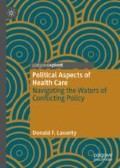Abstract
Near the end of the Clinton administration, the healthcare provider community was ably demonstrating the negative impact of the reductions enacted under the Balanced Budget Act, and Congress made efforts to moderate reductions by delaying implementation. Just months after Bush II’s inauguration, the terrorist attacks of September 11, 2001, put anti-terrorism initiatives at the top of the legislative agenda, but some healthcare progress was still made. Under the leadership of the Secretary of Health and Human Services, Congress passed the Medicare Prescription Drug Improvement and Modernization Act, allowing private health insurers to directly compete with Medicare. In 2005, Congress passed the Deficit Reduction Act which continued the BBA delays but also made changes to the Medicaid program. It was followed by the 2006 Tax Relief and Health Care Act which allowed another extension to delay implementation of the Sustainable Growth Rate formula, authorized an increase in Medicare Part B reimbursements for providers, and gave more flexibility to states to adapt and adopt their Medicaid programs to market forces. Near the end of Bush’s second term, the country slid into recession causing many employees to again lose healthcare benefits, bringing the struggles of the uninsured and underinsured back into the spotlight.
Access this chapter
Tax calculation will be finalised at checkout
Purchases are for personal use only
Notes
- 1.
Under the formula for Part B payment adopted in 1992 to reimburse Part B providers, all services were reimbursed one amount (the conversion factor), which, under the 1992 formula, is the amount paid.
References
Balanced Budget Act, Pub. L. No. 105-33, 111 Stat 251. 1997.
Children’s Health Insurance Program Reauthorization Act, Pub. L. No. 111-3. 2009.
Consolidated Omnibus Reconciliation Act, Pub. L. No. 99-272, 100 Stat 82. 1985.
Deficit Reduction Act, Pub. L. No. 109-171. 2005.
District of Columbia Appropriations Bill, Pub. L. No. 106-31. 1999.
Medicare Modernization Act, Pub. L. No. 108-173. 2003.
Author information
Authors and Affiliations
Copyright information
© 2018 The Author(s)
About this chapter
Cite this chapter
Lavanty, D.F. (2018). Healthcare Reductions and the “Donut Hole”. In: Political Aspects of Health Care. Palgrave Pivot, New York. https://doi.org/10.1057/978-1-137-40283-7_8
Download citation
DOI: https://doi.org/10.1057/978-1-137-40283-7_8
Published:
Publisher Name: Palgrave Pivot, New York
Print ISBN: 978-1-137-40620-0
Online ISBN: 978-1-137-40283-7
eBook Packages: Political Science and International StudiesPolitical Science and International Studies (R0)

